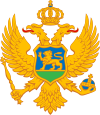 |
| Part of a series on |
| Montenegro |
|---|
| History |
| Geography |
| Politics |
| Economy |
| Society |
 |
| Part of a series on |
| Montenegro |
|---|
| History |
| Geography |
| Politics |
| Economy |
| Society |
Montenegro has two international airports, with their IATA Airport Codes:
Both airports were thoroughly reconstructed in 2006, with a new passenger terminal being built at Podgorica Airport. The airports had a combined traffic of 2,184,857 passengers in 2017. Both airports had more than 1 million passengers for the first time in 2017. [1]
There are also airports at Berane, Žabljak and Nikšić, but those are used mostly for general aviation, and are not equipped to handle larger aircraft. Ulcinj has a grass-type airport.
Graphs are unavailable due to technical issues. There is more info on Phabricator and on MediaWiki.org. |
total: 250 km
standard gauge: (1,435 mm (4 ft 8+1⁄2 in)) 250 km
narrow gauge: none
The Montenegrin part of the Belgrade–Bar railway is the backbone of the Montenegrin railway system. It opened in 1976, and then was a state-of-the art railway, with features such as the Mala Rijeka viaduct (highest railway viaduct in the world) and the 6.2 km long Sozina tunnel. About one-third of the Montenegrin part of the railway is in tunnels or on viaducts.
The railway suffered from chronic underfunding in the 1990s, resulting in it deteriorating and becoming unsafe. This culminated in the 2006 Bioče train disaster, when a passenger train derailed, killing 47 passengers. Efforts are being made to thoroughly reconstruct this railway. The European Investment Bank (EIB) agreed in January 2023 to provide finance of EUR 76 million for rail improvements on the Bar – Podgorica – Vrbnica rail line. [2]
The Nikšić-Podgorica railway (56,6 km long) was built in 1948 as a narrow gauge railway, and upgraded to standard gauge in 1965. From 1992 to 2012, it has been used solely for freight traffic, particularly bauxite from the Nikšić mine to the Podgorica Aluminium Plant, with the maximum speed on the railway reduced to 30 km/h. Railway was reconstructed and electrified in the 2006-2012 period, with passenger traffic starting in 2012 and maximum speeds being between 75 and 100 km/h.
The Podgorica–Shkodër railway, which extends to Tirana, has been used exclusively for freight traffic for some time. Parts in Albania were damaged in 1997, but the connection was restored in 2002. There are plans to reconstruct the railway and re-introduce passenger traffic, as it is important for the interests of both Montenegro and Albania. Currently, the railways are undergoing planned repairs and modernization with a budget, given by the government for 2009, of 9.7 million euros.


The overall length of roads in Montenegro is 5,277 km, of which 1,729 km is paved. The roads in Montenegro are categorized in the following way:
Sections of E65/E80 (Debeli Brijeg - Petrovac) and E851 (Petrovac - Ulcinj) together make up for the Montenegrin section of Adriatic Highway.
In January 2016, after many years, categories of roads have been changed to more reflect their importance and quality. [3] Before that categorization of some of the roads had become obsolete in some cases, with upgrades of some road sections, and decay of the others. For example, road Kolašin - Mateševo - Andrijevica road, was labelled as Main road, is greatly inferior in quality to the Šavnik - Žabljak road, which was designated as a Regional road.
In recent years roads connecting Podgorica and the coastal towns have improved significantly with the completion of Sozina tunnel and numerous upgrades of roads towards Cetinje, Budva and Bar. Sozina tunnel shortened the journey from Podgorica to Bar to under half an hour and made the trip significantly safer.
In the north, the road from Podgorica to Kolašin through Morača canyon to Serbia is considered the bottleneck of Montenegrin road network, as it is a curvy mountainous road, often unsafe during the winter. Bar - Boljare motorway is envisioned as a replacement for this corridor. In 2015, work has begun on section of Bar - Boljare motorway that would bypass the canyon. Long term plans also include the Montenegrin section of Adriatic–Ionian motorway as a significant transit link.
There is a proposed route from the city of Podgorica to Gusinje. The highway, expected to go through northwestern Albania, (from Grabom to Vermosh), will mean a journey time to Gusinje and Plav of about half an hour.
Also, the Verige bridge spanning the Bay of Kotor and part of the Adriatic Highway is planned to be built in the future.
This is a list of all main roads in Montenegro. [4]
| Designation | Route |
|---|---|
| Debeli Brijeg/Croatia - Meljine (M-12) - Lipci (M-8) - Kotor (R-1) - Krtolska crossroad (M-11) - Budva (M-10) - Petrovac (M-2) - Sutomore (M-1.1) - Bar (R-28 and R-29) - Ulcinj (R-22) - Krute (R-29) Vladimir (R-15) - Sukobin/Albania | |
| Sutomore (M-1) - Sozina Tunnel - Virpazar (raskrsnica sa M-2) | |
| Petrovac (M-1) - Sotonići - Virpazar (M-1.1 and R-15) - Golubovci - Podgorica (M-3, M-4 and R-27) - Bioče (R-13) - Mioska (R-21) - Kolašin (R-13) - Mojkovac (R-10) - Slijepač Most (R-11) - Ribarevina (M-5) - Bijelo Polje - Barski most/Serbia | |
| Šćepan Polje/Bosnia and Herzegovina - Plužine (R-16) - Jasenovo Polje (M-6) - Vir (R-7) - Nikšić (M-7) - Cerovo (R-23) - Danilovgrad (R-14) - Podgorica (M-10 and M-2) | |
| Podgorica (M-2) - Tuzi - Božaj/Albania | |
| Ribarevina (M-2) - Berane (R-2) - Budimlja (R-12) - Kalače (R-12) - Rožaje (R-5) - Most Zeleni (R-6) - Dračenovac/Serbia | |
| Ranče/Serbia - Trlica (R-11) - Pljevlja (R-18) - Đurđevića Tara (R-10) - Vrela (R-26) - Žabljak - Virak (R-20) - Pošćenski kraj (R-16) - Šavnik (R-20) - Jasenovo Polje (M-3) | |
| Nikšić (M-3)- Riđani (R-17) - Vilusi (M-8 and M-9) - Ilijino Brdo/Bosnia and Herzegovina | |
| Lipci (M-1) - Grahovo - Vilusi (M-7); | |
| Vilusi (M-7) - Petrovići - Deleuša/Bosnia and Herzegovina | |
| Podgorica (M-3) - Cetinje (R-1) - Budva (M-1); | |
| Lepetani (Ferry to M-1) - Tivat - Krtolska crossroad (M-1); | |
| Meljine (M-1) - Petijevići - Sitnica/Bosnia and Herzegovina |
Future Main road from Cetinje to Nikšić is currently under construction, with section from Cetinje to Čevo expected to be finished until the end of July, 2023. [5]
This is a list of regional roads in Montenegro. [4]
Port of Bar is the major seaport in Montenegro. It is capable of handling about 5 million tons of cargo, and is a port for ferries to Bari and Ancona in Italy. Kotor, Risan, Tivat and Zelenika (in Bay of Kotor) are smaller ports.
Montenegro's rivers are generally not navigable, except for tourist attractions such as rafting on Tara River.

Podgorica is the capital and largest city of Montenegro. The city is just north of Lake Skadar and close to coastal destinations on the Adriatic Sea. Historically, it was Podgorica's position at the confluence of the Ribnica and Morača rivers and at the meeting-point of the fertile Zeta Plain and Bjelopavlići Valley that encouraged settlement. The surrounding landscape is predominantly mountainous terrain.
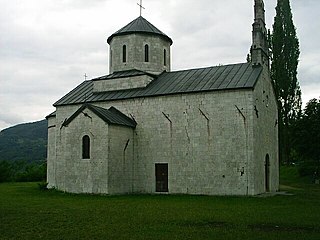
Andrijevica is a town and the seat of Andrijevica Municipality in Polimlje region in eastern Montenegro. According to the 2023 Census of Montenegro, it had a population of 988.

Ulcinj is a town on the southern coast of Montenegro and the capital of Ulcinj Municipality. It has an urban population of 10,707 (2011), the majority being Albanians.

The Zeta Banovina, was a province (banovina) of the Kingdom of Yugoslavia between 1929 and 1941. This province consisted of all of present-day Montenegro as well as adjacent parts of Central Serbia, Croatia, Kosovo and Bosnia and Herzegovina. It was named after the Zeta River which also gave its name to the medieval state of Zeta that roughly corresponds to modern-day Montenegro. The capital of Banovina was Cetinje.

Kolašin is a town in northern Montenegro. It has a population of 2,989. Kolašin is the centre of Kolašin Municipality and an unofficial centre of Morača region, named after Morača River.
Albanians in Montenegro are an ethnic group in Montenegro of Albanian descent, which constitute 4.91% of Montenegro's total population. They are the largest non-Slavic ethnic group in Montenegro.

The Armed Forces of Montenegro are the military forces of Montenegro. The Armed Forces consists of an army, navy and air force.

The Adriatic Highway is a road that stretches along the eastern coast of the Adriatic Sea and is part of the European route E65. The road passes through Croatia, with smaller stretches through Bosnia and Herzegovina and Montenegro and ends at the Montenegro-Albania border. It is an undivided two-lane road for almost its entire length, with the exception of a short stretch through Zadar and a 24 kilometres (15 mi) dual-carriageway section from Plano (Trogir) to the southeast suburbs of Split. It was planned in the 1930s and built in the 50s and 60s. The dual carriageway is planned to be extended further southeast to Omiš. Completion of the Adriatic Ionian motorway is proposed in order to replace Adriatic Highway as a high-performance road transport route along the Adriatic coast.
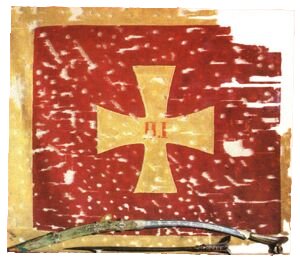
The Montenegrin–Ottoman War, also known in Montenegro as the Great War, was fought between the Principality of Montenegro and the Ottoman Empire between 1876 and 1878. The war ended with Montenegrin victory and Ottoman defeat in the larger Russo-Turkish War of 1877–1878. Six major and 27 smaller battles were fought, among which was the crucial Battle of Vučji Do.

Rail transport in Montenegro is operated by four separate companies, which independently handle railway infrastructure, passenger transport, cargo transport and maintenance of the rolling stock. The four companies were a part of public company Railways of Montenegro until it was split up in 2008.

Belgrade–Bar motorway is a future motorway that will connect the Serbian capital of Belgrade and Bar, Montenegro's main seaport. Italy, Montenegro and Serbia are lobbying to list the route with Pan-European corridors, and it is frequently referred to as part of proposed Corridor XI, or 4B – an envisioned motorway/ferry corridor linking Bari, Bar, Belgrade and Bucharest.

Adriatic–Ionian motorway or Trieste-Kalamata Highway or the Blue Corridor, is a future motorway that will stretch along the entire eastern shore of the Adriatic and Ionian seas, spanning the western coast of the Balkan peninsula from Italy in the north through Slovenia, Croatia, Montenegro, Albania to Greece in the south.
The Podgorica–Shkodër railway is a railway connecting Albania and Montenegro, used for freight-purposes only. It is Albania's only international rail link. Although initially built between 1984 and 1985, it fell into disuse in 1991 and later fully reopened in 2003.
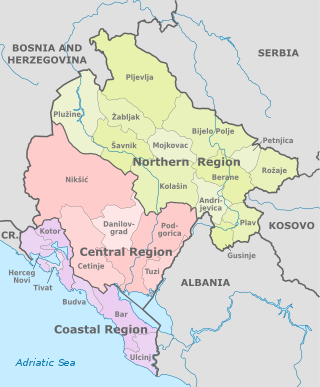
Statistical regions of Montenegro are defined, as of 2011, by the Montenegrin Regional Development Law. The regions, as defined by law, roughly correspond to the informal and colloquial division of Montenegro, often used by the Montenegrin media and citizens.

The M-2 highway is a Montenegrin roadway.

Montenegro has had a motorway since July 13, 2022, when the first section of the Bar-Boljare motorway was inaugurated.

M-1 highway is a Montenegrin roadway.
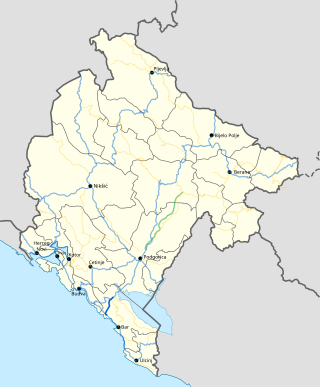
M-1.1 highway is a Montenegrin roadway.

R-13 regional road is a Montenegrin roadway.

The A-1 motorway, called Princess Xenia motorway, named after the Princess Xenia of Montenegro, first female driver in Balkans, is a motorway in Montenegro. This motorway is also known as the Bar-Boljare motorway. In 2022, first part of the motorway was finished from Smokovac near Podgorica to Mateševo near Kolašin.